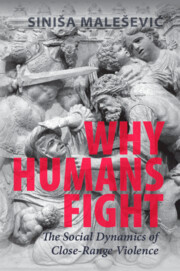Book contents
- Why Humans Fight
- Why Humans Fight
- Copyright page
- Dedication
- Contents
- Acknowledgements
- Introduction
- 1 The Body and the Mind
- 2 Profiting from Fighting
- 3 Clashing Beliefs
- 4 Enforced Fighting
- 5 Fighting for Others
- 6 Avoiding Violence
- 7 Social Pugnacity in the Combat Zone
- 8 Organisational Power and Social Cohesion on the Battlefield
- 9 Emotions and Close-Range Fighting
- 10 Killing in War
- 11 The Future of Close-Range Violence
- Conclusion
- Appendix Methodology and Data Collection
- References
- Index
8 - Organisational Power and Social Cohesion on the Battlefield
Published online by Cambridge University Press: 29 September 2022
- Why Humans Fight
- Why Humans Fight
- Copyright page
- Dedication
- Contents
- Acknowledgements
- Introduction
- 1 The Body and the Mind
- 2 Profiting from Fighting
- 3 Clashing Beliefs
- 4 Enforced Fighting
- 5 Fighting for Others
- 6 Avoiding Violence
- 7 Social Pugnacity in the Combat Zone
- 8 Organisational Power and Social Cohesion on the Battlefield
- 9 Emotions and Close-Range Fighting
- 10 Killing in War
- 11 The Future of Close-Range Violence
- Conclusion
- Appendix Methodology and Data Collection
- References
- Index
Summary
Most scholars and military practitioners agree that social cohesion plays a crucial role on the battlefield. If soldiers do not trust their comrades and officers, they are unlikely to fight well or at all. Nevertheless, there is no agreement on the question: What are the key sources of group cohesion? Some authors emphasise the psychological variables and focus on the cognitive aspects of in-group bonding while others identify shared social action and professional performance as the principal causes of the willingness to fight. In this chapter I question the centrality of these two explanatory paradigms by shifting the debate towards the structural contexts. More specifically I argue that the success or failure of micro-level social cohesion is determined by its relationship with organisational power. In other words, social cohesion is rarely an autonomous phenomenon that can be completely divorced from the organisational capacity of armed forces. In many cases these two are mutually interdependent processes the workings of which often determine the long-term trajectories of a particular conflict. By zooming in on the case studies of the Croatian Army (HV) and the Bosnian Serb Army (VRS) during the 1991–5 Wars of Yugoslav Succession, I show how unit cohesion and social pugnacity are enhanced and sustained by organisational development. Hence, despite the initial similarities in the level of fighting motivation in the armies, the long-term structural input proved decisive for military success: the HV maintained strong army-wide networks of micro-group solidarity and won the war whereas the VRS never developed such models of social cohesion and ultimately lost large swaths of territory finding itself on the verge of complete collapse. The different experiences of these two military organisations indicate clearly that social cohesion and social pugnacity are not just psychological phenomena defined by the micro-level social action but are a long-term processes regularly shaped by the wider structural forces.
Keywords
- Type
- Chapter
- Information
- Why Humans FightThe Social Dynamics of Close-Range Violence, pp. 222 - 250Publisher: Cambridge University PressPrint publication year: 2022

